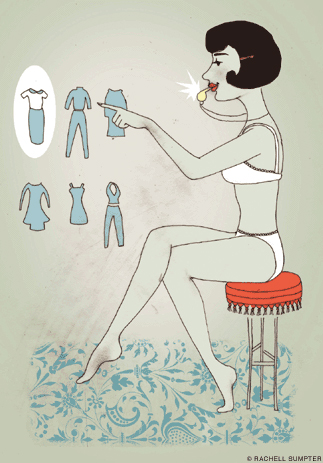
How to make your clothes—and everything else—fit your goals in life.
By Kim Johnson Gros
A few years ago, when Chic Simple Men’s Wardrobe was published, I was asked to be a guest on a radio show hosted by G. Gordon Liddy. Yes, the one-time G-man who captured criminals on the 10 Most Wanted List as a young bureau supervisor in the FBI, who trained as a paratrooper in Israel, who served time in a maximum-security prison for his role in Watergate, and who is today a septuagenarian who drives a 200 mph sports car when not on one of his Harleys—this macho maverick wanted to talk clothes. He also wanted to share a story.
Liddy’s father-in-law was a respected judge who was equally recognized for his sartorial flair. He enjoyed clothes of quality and took pride in the way he dressed each day. So much so that, the day he came home with a new pair of poorly made, inexpensive shoes, his family understood he was signaling that his death was imminent, and it was no longer worth it to him to spend money on life.
Clothes talk. They can signal power, protest, or respect. Clothes can offer comfort and confidence, whether you’re dressed to paddle white water or to interview for a job. You can look like a million bucks, or like you don’t have a buck. We all get dressed everyday and, like it or not, what you wear says something about you. And it’s not about fashion, unless you choose it to be. It’s about clothes, what you put on your body.
Clothes have defined my career—as a young Ford model wearing fashion, as an advertising designer selling the allure of fashion, as a reporter on fashion, as a magazine editor and columnist, and more recently as co-founder of the Chic Simple lifestyle book series and partner in Mdash, a branding consultancy. So far there have been 25 books in the Chic Simple series, with sales of more than 1.5 million copies, aimed at sharing how to simplify your life with economy and style.
Clothes have taught me lessons. I have learned that fashion is different than clothes. Fashion is what we observe, but, for most of us, it is not about the way we live. Fashion may be what we buy and put in our closets, but clothes are what we take out of the closet and wear.
I have also learned that having a wardrobe is a way of having control of your life. A wardrobeconsists of those few things you depend on to get through your day with ease. It’s like the perfect recipe that you can always rely on. It’s not about owning a lot, but simply owning what you need and enjoy. In fact, Chic Simple opens each book with the Aborigine proverb: “The more you know, the less you need.” Having a closet full of clothes and thinking you have nothing to wear is out of control. Knowing you have an outfit in which you look and feel your best—that is control.
This wardrobe concept is not limited to clothes. It may be one of recipes, or a garden plan, or the things that make your home more livable and comfortable. For me it’s having a scrumptious bed that feels like I’m getting a big hug when I climb into it at night; in the office, a chair I can sit comfortably in while working for hours; at home, a place to read with proper lighting; and for entertaining, a table for dining with family and friends.
The idea of wardrobes is that they can simplify and enrich your life when you make choices that are right for you. So where does one start? Over the course of creating 25 Chic Simple books, we developed a three-step process to help you create wardrobes that are tailored for your life.
1. Assess: Examine your life, and think about what you need. Match your possessions with your life. It will give you focus.
2. Dejunk: Get rid of what you don’t need or enjoy. It takes courage to let go.
3. Renew: What’s left, what’s missing? Do you have what you need? If not, get it.
This process will help you to be more aware of how you are living your life. It’s a moment: “Am I enjoying my morning coffee and the cup I’m drinking from, or am I gulping it on the run without thought or pleasure?”
The Chic Simple process helped me make the big moments in life (new home, new job, new stage) a little less scary, because as goals and life change, I am constantly assessing what matters and jettisoning what doesn’t.
I recently went through a divorce, and this same process helped me decide how to live the next part of my life.
Step 1, I assessed my priorities: to live close to my ex-husband so our daughters could easily go back and forth. I chose not to buy a house, because it would have felt like having another job. I wanted an apartment that felt like a five-star hotel suite—easy to care for, and with supers to handle the inevitable leaky toilet and icy walkways. And now that my children are older, I would rather spend my money exploring the world with them than on a mortgage.
Step 2, I dejunked: This is a necessity when moving into a smaller home, understanding what is really me and what is just baggage.
Step 3, I renewed: I sought out what I needed in my new situation and surrounded myself with the things I love (like my cozy bed).
This mindful exercise helps you discern how to make choices that are right for you as your life and goals continue to change—whether graduating from college, starting a family or a new career, or entering the third trimester of life. It takes time, courage, discipline, and patience. It’s a daily practice, a seasonal practice, and an ongoing life practice. Start small—one “wardrobe” at a time, one closet at a time, one room at a time.
I wondered why G. Gordon Liddy and I got choked up over his story about this renowned judge, his father-in-law, buying a cheap pair of shoes.
Perhaps it was because being mindful and enjoying the everyday things in our lives—the food we eat, the clothes we wear, and how we want our home to feel, is life-affirming. When we choose to ignore them, or in Liddy’s father-in-law’s case, give up on them, we have relinquished control. We essentially have stopped writing the stories of our lives. For me, I never want to stop writing the story of my life. It’s about moving on, rather than hanging on to the past.
Kim Johnson Gross CW’74 is co-founder of Chic Simple and Mdash.




